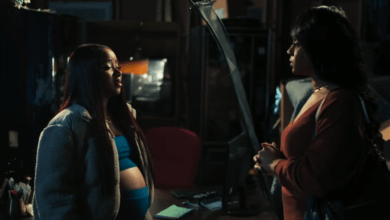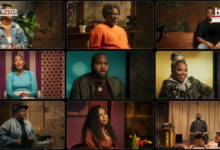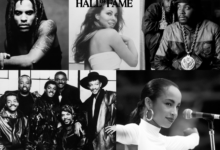‘GOOD HAIR’ MOVIE POSTER AND FILM INFO

An exposé of comic proportions that only Chris Rock could pull off, GOOD HAIR visits beauty salons and hairstyling battles, scientific laboratories and Indian temples to explore the way hairstyles impact the activities, pocketbooks, sexual relationships, and self-esteem of the black community. Director Jeff Stilson follows Chris Rock on this raucous adventure prompted by Rock’s daughter approaching him and asking, “Daddy, how come I don’t have good hair?” Haircare professionals, beautyshop and barbershop patrons, as well as celebrities including Ice-T, Nia Long, Paul Mooney, Raven Symoné, Dr. Maya Angelou, Salt n Pepa, Eve and Reverend Al Sharpton all candidly offer their stories and observations to Rock while he struggles with the task of figuring out how to respond to his daughter’s question.
GOOD HAIR marks a reunion of the team behind Rock?s acclaimed and Emmy® Award-winning HBO series The Chris Rock Show, including producer Nelson George, writer-director Jeff Stilson, writers Lance Crouther and Chuck Sklar. The film is produced by Chris Rock and Kevin O?Donnell.
GOOD HAIR is presented by HBO Films and released theatrically by Liddell Entertainment and Roadside Attractions.
GOOD HAIR’S ROOTS
A question from Chris Rock?s daughter jumpstarted the making of Good Hair, but the idea for a documentary about the culture of black hair actually took root in Rock?s head about 15 years ago while doing a stand-up gig in Atlanta. He noticed his hotel was packed with people, and everyone seemed to be there for the same reason: the Bronner Bros. Hair Show. He?d never heard of it, but to the over 100,000 attendees it?s a yearly tradition stretching back to the early „50s, with hairstylists, barbers, and hair fanatics from all over the world coming together to discover what?s new, best, and different in black hair care. It was a massive gathering, and Rock couldn?t believe what a passionate, colorful crowd they were. In short, Rock discovered what a big crazy business black hair was.
“I’ve been around hairdressers my whole life,” he says, “but I’d never seen anything like this – it was just a whole another vibe. So 15 years ago, I had the idea this would make a great film.”
The idea laid dormant until years later when Rock?s daughter asked about her “bad hair.” He was astonished. “I tell my daughters I love them 70 times a day,” he says. “I hug them and I kiss them – I’m that kind of dad. To hear my daughter did not like something about herself when I’m telling her she’s beautiful every single minute of the day really had me thinking about hair again.
“She was only five at the time,” he continues, “and she was already having concerns about her hair – she?s already having hair envy. I felt I needed to understand more deeply how these issues are related: African-American women and their hair. And then I remembered the idea for a documentary.”
As he thought about it anew, he saw a real possibility to explore and gain further understanding of the topic through making a film. And if the attendees at Bonner Bros. were any indication, he knew he?d be entertaining people in the process. His passion for the project quickly found a home and structure through his HBO relationships, and the film steadily began to take shape.
WEAVING A STORY
Good Hair is a discovery piece. It includes firsthand, often hysterical, accounts of women?s attitudes about their hair – and ultimately reveals their feelings about their own beauty and self-esteem. Rock was shocked to discover the financial investment women make in their hair and the extreme cost of the best extensions and weaves. He saw a great divide between those women who feel it preferable and even necessary to relax or straighten their hair versus those who want to leave their hair natural. During shooting, all involved were amazed to discover how deep-rooted everyone?s feelings on the issues were, regardless of topic, and surprised by the extent to which some women will go to conform to a societal standard.
“In our world, the issues of beauty and conformity run very deep – and men don?t always understand how truly deep those issues go for women,” says executive producer Nelson George. “It reaches all women: Asian, Hispanic, black, and white.”
And for black women, the issue can be incredibly polarizing, affecting other areas of their lives – there?s a segment in the film where men discuss not ever having touched their wives? hair. “One thing we didn’t really know when we started,” says George, “was how deeply we would get into this whole question of black men and women, and the financial considerations and intimacy issues that evolve with taking care of a woman’s hair. That was something we discovered – literally, Chris is amazed on screen to touch a black woman’s hair AND REALIZES HOW LOADED THAT MOMENT IS. That’s the moment it hit him. The film really builds on this issue of intimacy and how something like hair can affect how people love each other.”
One of the most revealing questions raised in the film is summed up by actress Tracie Thoms, one of Good Hair?s interviewees. Thoms has chosen to wear her hair “natural,” but she admits how strong her conviction must be to keep it that way. “There are so many pressures to straighten your hair. To keep my hair the same texture as it grows out of my head is looked at as revolutionary. Why is that?”
Many of the film?s subjects talk about the pressures of style and what it currently means to have good hair…or to not have it. Their sentiments are echoed by hair professionals and even very young girls who have already been exposed to society?s demands. “There?s always this pressure in the black community,” says actress Nia Long. “If you have good hair, you?re prettier or better than the brown-skinned girl who
wears the afro or the dreads or the natural hairstyle.” Surprisingly, even though many women in the film acknowledge the “unnatural response to natural,” they?re still pulling out their credit cards for relaxers and extensions.
Sheila Bridges, an interior designer who appears in the film, says, “Hair is so important because our self-esteem is wrapped up in it. It?s like a type of currency – even though those standards are completely unrealistic and unattainable, especially for black women.” Rendered bald by alopecia, Bridges chose to not wear a wig because, “I never wanted to feel like I was hiding something. I wanted to deal with accepting who you are, looking in the mirror and feeling as though you?re beautiful and legitimate.”
HAIR BATTLE
The film blends interviews with footage of the filmmakers? journeys all over the U.S. and overseas. One of the main features of the film is the Bronner Bros. Hair Show in Atlanta, GA, which served as a source of information for the filmmakers in addition to providing a narrative throughline to the picture with its Hair Battle and contestants.
The Bronner Bros. Hair Show is attended by more than 120,000 hair care professionals each year. It has been the largest of all hair conventions for more than 60 years and annually pumps about $60 million into the Atlanta community. Rock, along with his longtime writing partners from The Chris Rock Show and other projects (Jeff Stilson, Chuck Sklar and Lance Crouther), decided to start their research at the show in August 2006. “We walked the floor at the show,” says Rock. “They have everything that relates to hair – from new products to information on opening your own business.” Just being there was incredibly informative – it was like having the world?s largest library of hair-related information at their disposal. It was the knowledge gained at this first show that helped inform their choices for interview subjects, shooting locations, and topics to cover.
They then spent several months researching and planning to actually shoot at the next Bronner Bros. Hair Show in February 2007. During summer 2006, the Hair Battle contestants were finalized and the filmmakers spent time with each as they prepared for the 2007 Hair Battle Royale, the hair show finale. The cutters shown in the film include Tanya Crumel and Kevin Kirk from Birmingham, Alabama; Jason Griggers of Atlanta; Freddie J from Dallas; and Derek J in Atlanta. In the world of hair, these -6-
stylists are rock stars, replete with entourages, backup dancers, outrageous style, and an amazing, eye-popping degree of showmanship with scissors.
In February 2007, they shot as much footage and as many interviews as they could at the Show, including information about products, techniques, and related industries like chairs, tools and weaves – all of which generate a shocking amount of revenue. The business of making hair look good has made many people rich. “The show really helped us understand the whole business,” says Rock. “It?s huge.”
Their research also led the filmmakers to want an understanding of the origin of certain hair products, weaves and relaxers. The history of hair is rich, and to learn more about it they traveled to one of the few and oldest African-American-owned hair product companies: Dudley Products in Greensboro, North Carolina. To back up their scientific knowledge on the subject, they also interviewed a chemist to discuss the chemical content of relaxer. The stuff women regularly put in their hair can leave chemical burns and dissolve Coke cans.
Finally, the filmmakers wanted to connect with people around the country to round out their interview list. “Growing up in Brooklyn,” says Rock, “I knew that we would need to spend a lot of time in real beauty shops and barbershops. We felt testimonials were another important part of the film, so we went to shoot in barbershops, beauty parlors, weave places, braid places and even hair dealers. We wanted to reach an array of women, so we hit places in New York, Atlanta, Birmingham and Dallas. There?s also some revealing stuff about the men who are waiting for the women getting their hair done.”
HAIR SUPPLY
Extensions are a big part of the hair business – it?s estimated that hair weaves make up about 65% of the $9 billion in hair revenue. Depending on the kind of extension (partial, full head for fullness, full head for fullness and length, etc.) and the kind of hair used (synthetic or human), they can cost anywhere from $400 to $4000 and more…and they only last a few months. That means women regularly spending thousands of dollars on their hair every year – and sitting there for up to 8 hours at a time to get it done.
After being on the floor of the hair show and talking with industry experts, the filmmakers learned that most of the human hair used in creating extensions was coming from India, China and other parts of Asia. In fall 2007, they traveled to India to interview the sources of hair being used in U.S. salons.
They discovered that human hair is one of India?s largest exports. At a Hindu Temple in India, the crew talked with women who actually cut their hair in a ceremony where it is sacrificed for God. Of shedding her hair for God, one woman says, “When he fulfilled my desires, I promised him I?d give him my hair.” Strangely, she hadn?t thought about where her hair goes.
Each year, more than 10 million people in India sacrifice their hair in a religious ceremony called tonsuring. Nearly 85% of the population has tonsured their hair at least twice in their lifetime. After the hair is cut, it is processed and sold to international hair dealers. It is then sent to the United States and sold to domestic hair dealers, who in turn sell it to clients at hair shows and salons.
“India is an incredibly spiritual place,” George says. “The temple was really beautiful, but the area around it was incredibly raw and poor. The thing that really struck us was the fact that the hair from the Hindus who give it away as a gesture to God is actually the backbone of a multi-million dollar business. That was quite ironic to us.”
In Theaters October 9th!








